Based on 746 reviews
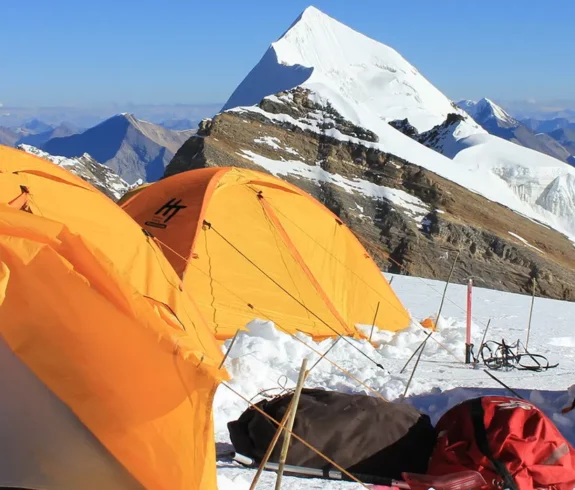
Putha Hiunchuli Expedition
Summiting the Silent Giant captures the spirit of Putha Hiunchuli Climbing
Duration
Meals
- 32 Breakfast
- 29 Lunch
- 30 Dinner
Accommodation
- The Everest Hotel
- Local Lodge
- Tented Camp
Activities
- Expedition
- Trekking
- Sightseeing
SAVE
€ 2690Price Starts From
€ 13450
Overview of Putha Hiunchuli Expedition
Putha Hiunchuli Expedition presents an incredible adventure in the secluded regions of Lower Dolpo and the southwestern areas of the Dhaulagiri Himalayas. Far from the bustling world, this expedition is a remarkable experience amidst wild and stunning landscapes, highlighted by breathtaking snow-capped peaks. Putha Hiunchuli, also known as Dhaulagiri VII, rises majestically to 7,246 meters (23,773 feet) and is a part of the impressive Dhaulagiri Himalaya range.
The trek towards Putha Hiunchuli-Dhaulagiri VII Peak explores seldom-trodden paths, beginning at the historic Tarakot village. This village, steeped in history from the Malla kingdom era, is the gateway to this enriching cultural and physical expedition. The route then winds through the Dolpo district’s main town, Dunai, and past remote villages like Panjing and Kagkot Gaon.
Trip Highlights
- First Ascent Tribute: Celebrating Jimmy Roberts and Ang Nima Sherpa’s pioneering 1954 ascent.
- Summit Panorama: Enjoy breathtaking views of Dhaulagiri and Annapurna from the top.
- Cultural Exploration: Immersing in Lower Dolpo’s unique cultural heritage and villages.
- Varied Terrain: Traversing diverse landscapes, from green valleys to stark mountains.
- Remote Expedition: Experiencing the solitude and pristine nature of the Himalayan wilderness.
- Climbing Challenge: Tackling a mix of technical and non-technical climbing paths.
- Ecological Discovery: Encountering distinct wildlife and plants native to the region.
Trekkers can engage with traditional rural life and visit ancient monasteries. The ascent involves gradual elevation gain, moving through pastoral lands to the interim and then the Putha Hiunchuli base camps, where climbers acclimatize and prepare for the summit push.
Putha Hiunchuli Expedition primarily follows the North-East Face, traversing the Kaya Khola stream to establish higher camps en route. Climbers encounter a mix of straightforward and technical terrains, often necessitating fixed ropes for safety. Reaching the summit unfolds a spectacular panorama of the Dhaulagiri Himalaya and Annapurna ranges, offering a sense of achievement and awe.
The descent is a careful trek back, emphasizing environmental preservation. The adventure concludes with a return to civilization, from Dunai and Jhupal to Kathmandu, leaving climbers with unforgettable memories of both the thrill of the climb and the cultural immersion in the Himalayas.
Historical Significance of the Putha Hiunchuli Expedition
The Putha Hiunchuli Expedition has made a significant impact on mountaineering history. On October 17, 1954, Jimmy Roberts, a pioneer in Himalayan exploration, and Ang Nima Sherpa, an expert climber, first reached the summit of Putha Hiunchuli, also known as Dhaulagiri VII.
Their climb was significant in climbing at high altitudes, mainly because they had limited technology and knowledge about the Himalayas. The success of climbing Putha Hiunchuli opened new opportunities for exploring the Dhaulagiri range and the culturally rich Lower Dolpo region, which people had yet to explore much before.
Detail Itinerary of Putha Hiunchuli Expedition
Day 01: Arrive in Kathmandu; Hotel Transfer
When travelers arrive in Kathmandu for their Putha Hiunchuli Expedition trip, they go straight to their hotels. Kathmandu, Nepal’s lively capital, begins its exciting expedition.
The first day is essential for them to get comfortable in the new place, which helps them relax and get used to the local setting. Before they begin the difficult ascent, this is a crucial phase.
On this first day in Kathmandu, travelers taste Nepal’s rich culture, busy streets, and historical sights.
It is a critical time for those going on the Putha Hiunchuli climb to rest and get over their jet lag. This rest is crucial for them to prepare, mentally and physically, for the demanding climb ahead.
Accommodation: The Everest Hotel
Meals: Not Included
Day 02: Kathmandu Sightseeing and Trek/Climb Preparations
On this day, trekkers dive into the lively culture of Kathmandu. They visit famous historical spots like Durbar Square, the Monkey Temple (Swayambhunath), and Pashupatinath Temple.
These places show them Nepal’s rich history and traditions, adding special memories before their climb.
At the same time, they use the day to get ready for the Putha Hiunchuli Expedition. They check their equipment and listen to detailed briefings about the climb.
This preparation ensures that climbers are ready for any situation and have a strong chance of success.
Accommodation: The Everest Hotel
Meals: Breakfast
Day 03: Fly from Kathmandu to Nepalgunj (50-minute scenic flight); Hotel Transfer
For the Putha Hiunchuli Expedition trip, travelers take a beautiful 50-minute flight to Nepalgunj.
During the flight, they enjoy amazing views of the Himalayas. The excitement for their climb grows as they fly over these majestic mountains.
After they land in Nepalgunj, a city in Western Nepal’s lowlands, they go to a local hotel.
Staying here is an essential part of their trip to Putha Hiunchuli. It gives them time to rest and get used to a different climate at lower altitudes before moving to the higher mountains.
Accommodation: Hotel
Meals: Breakfast, Lunch, and Dinner
Day 04: Fly from Nepalgunj to Jhupal, Dolpo (2,475 m); Drive to Dunai (2,140 m) - Flight: 50 minutes; Drive: 1 hour
For the next part of their Putha Hiunchuli Expedition adventure, the trekkers fly to Jhupal in the Dolpo area. Dolpo is famous for its remote and stunning nature, perfect for an exciting trek.
Once they arrive in Jhupal, the group drives for 2 hours to reach Dunai, an important town in the Dolpo district. This town is where their trek starts, as it’s the entrance to the paths that lead to Putha Hiunchuli.
Accommodation: Teahouse
Meals: Breakfast, Lunch, and Dinner
Day 05: Trek from Dunai to Tarakot (2,540 m) - Trekking: 5-6 hours
The Putha Hiunchuli Expedition team heads on a 6-hour trek to Tarakot, a village famous for its old fort. Tarakot is much more than a picturesque spot; it’s rich in history. Once a thriving trade hub, the village is essential to the area’s cultural heritage.
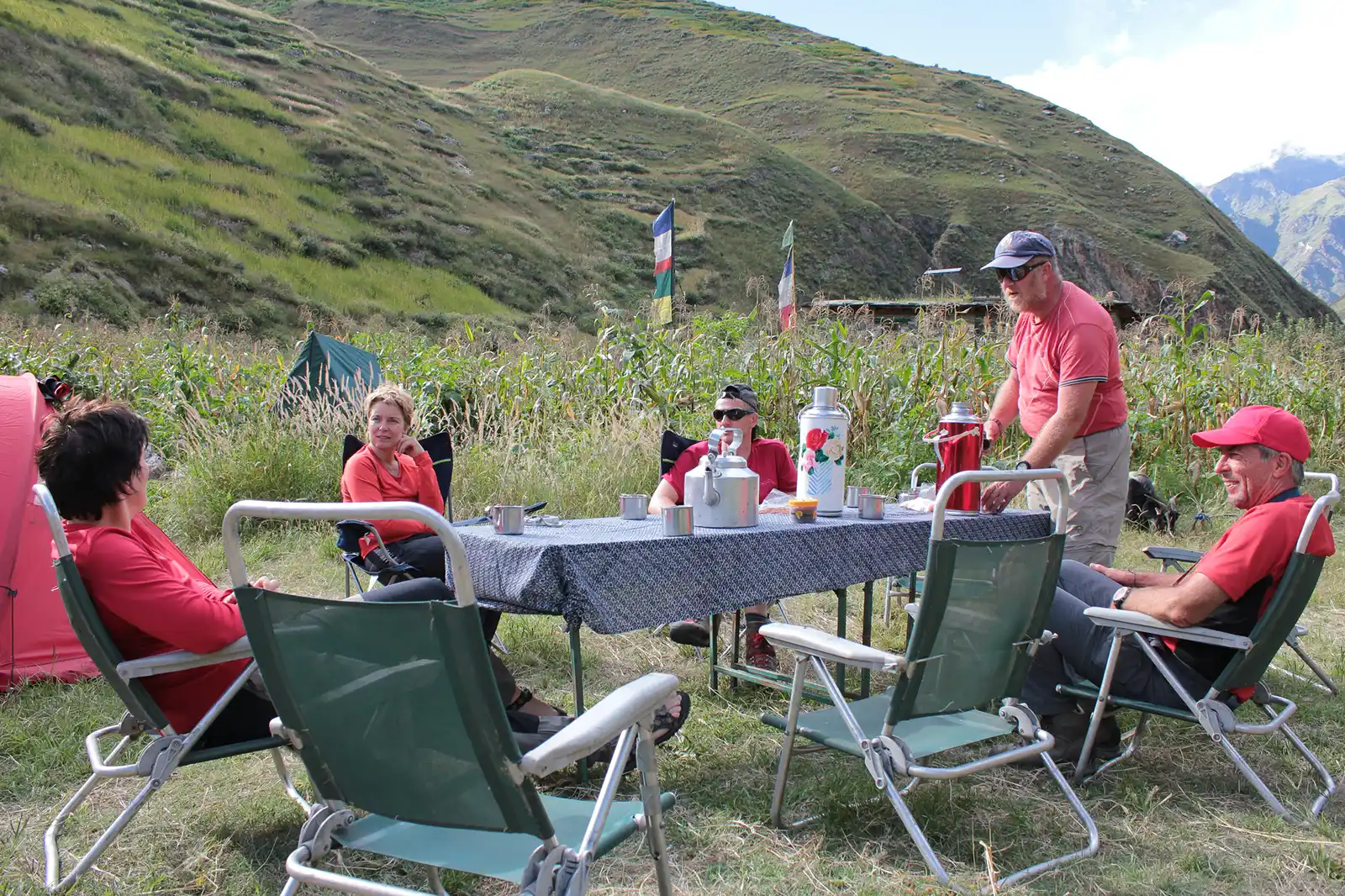
While trekking to Tarakot, the climbers are essentially walking through history. The village’s old buildings and fort, which have seen many changes over the years, provide a unique look into the past.
Accommodation: Teahouse
Meals: Breakfast, Lunch, and Dinner
Day 06: Trek from Tarakot to Musi/Barbung Khola (2,890 m); Set Camp - Trekking: 6-7 hours
In the Putha Hiunchuli Expedition trip, the trekkers begin on a 5-hour trek towards Musi or Barbung Khola. This trek is filled with scenic paths winding through peaceful natural settings, providing a beautiful environment for the day’s trek.
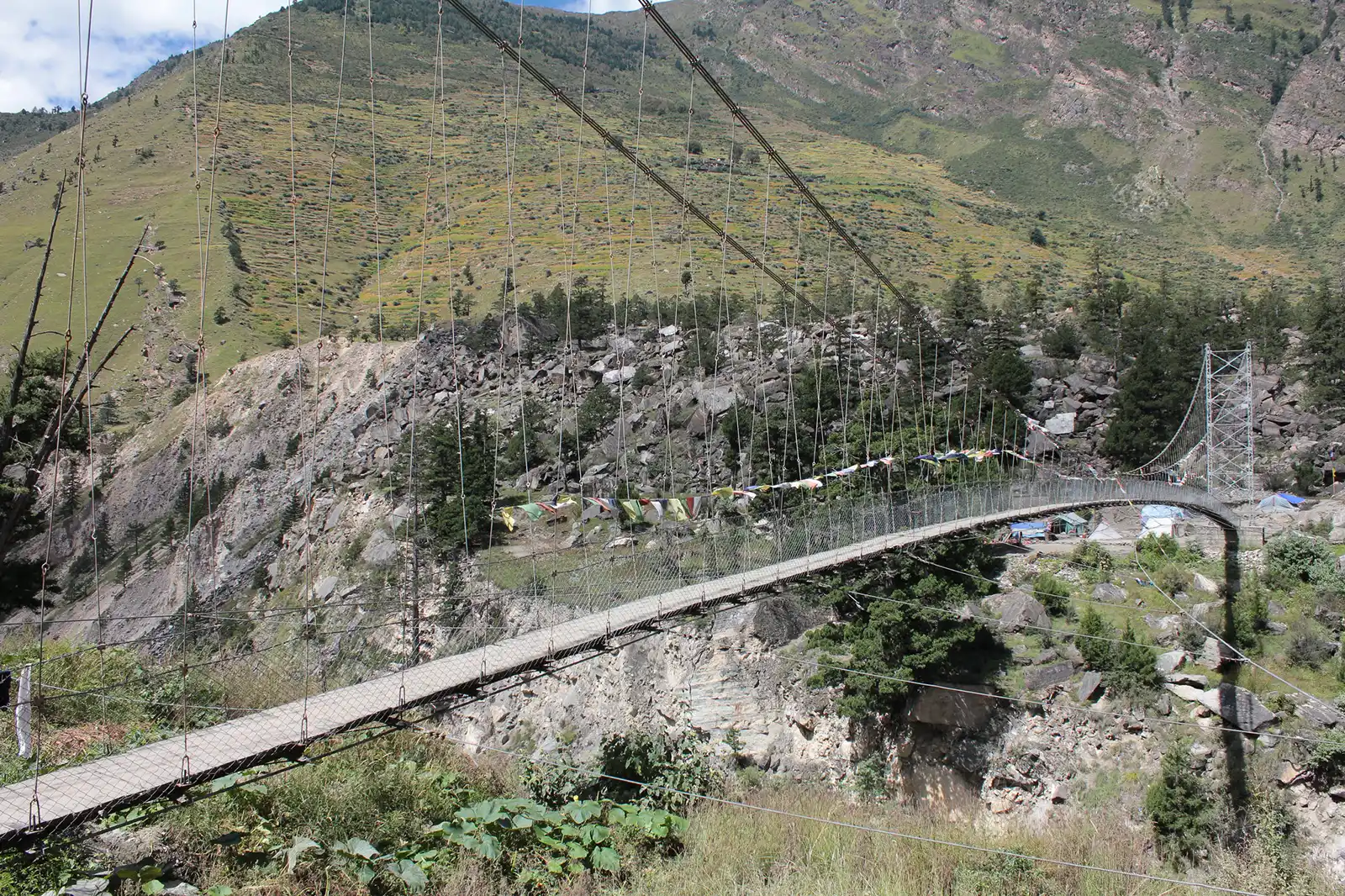
When they arrived, they set up their camp near the river. Camping by the river offers a lovely resting place, adding a peaceful element to their experience.
The gentle sound of the river and the area’s natural beauty make for a perfect setting to relax and prepare for the next part of their adventure.
Accommodation: Tented Camp
Meals: Breakfast, Lunch, and Dinner
Day 07: Trek from Musi/Barbung Khola to Kagkot Gaon; Camp at Kagkot Monastery (3,285 m) - Trekking: 6-7 hours
The climbers spend about 5 hours walking through Kagkot Gaon, a traditional village in the Himalayas. This part of the trek lets them see the local lifestyle up close. They observe the villagers’ daily activities and learn about their customs, adding a deep cultural dimension to their trek.
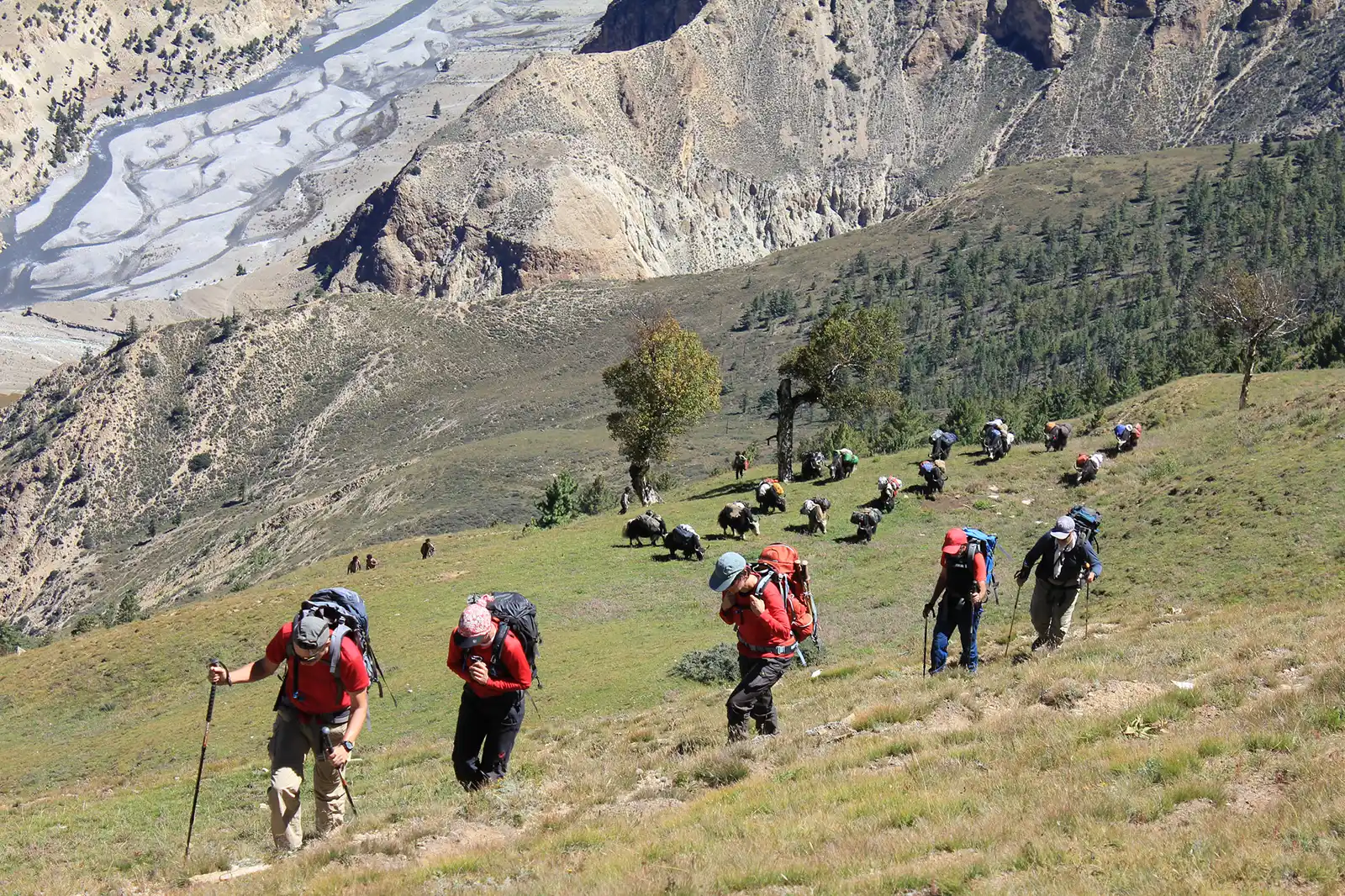
The trek ends for the day with the trekkers setting up their camp near the Kagkot monastery at 3,285 meters. The trekkers explore the monastery, learning about the area’s religious traditions and history.
Accommodation: Tented Camp
Meals: Breakfast, Lunch, and Dinner
Day 08: Acclimatization and Exploration Day at Kagkot Gaon
During the Putha Hiunchuli Expedition trip, the trekkers take a day off for acclimatization. To help their bodies acclimate to high altitudes and avoid altitude sickness, they must take this break.
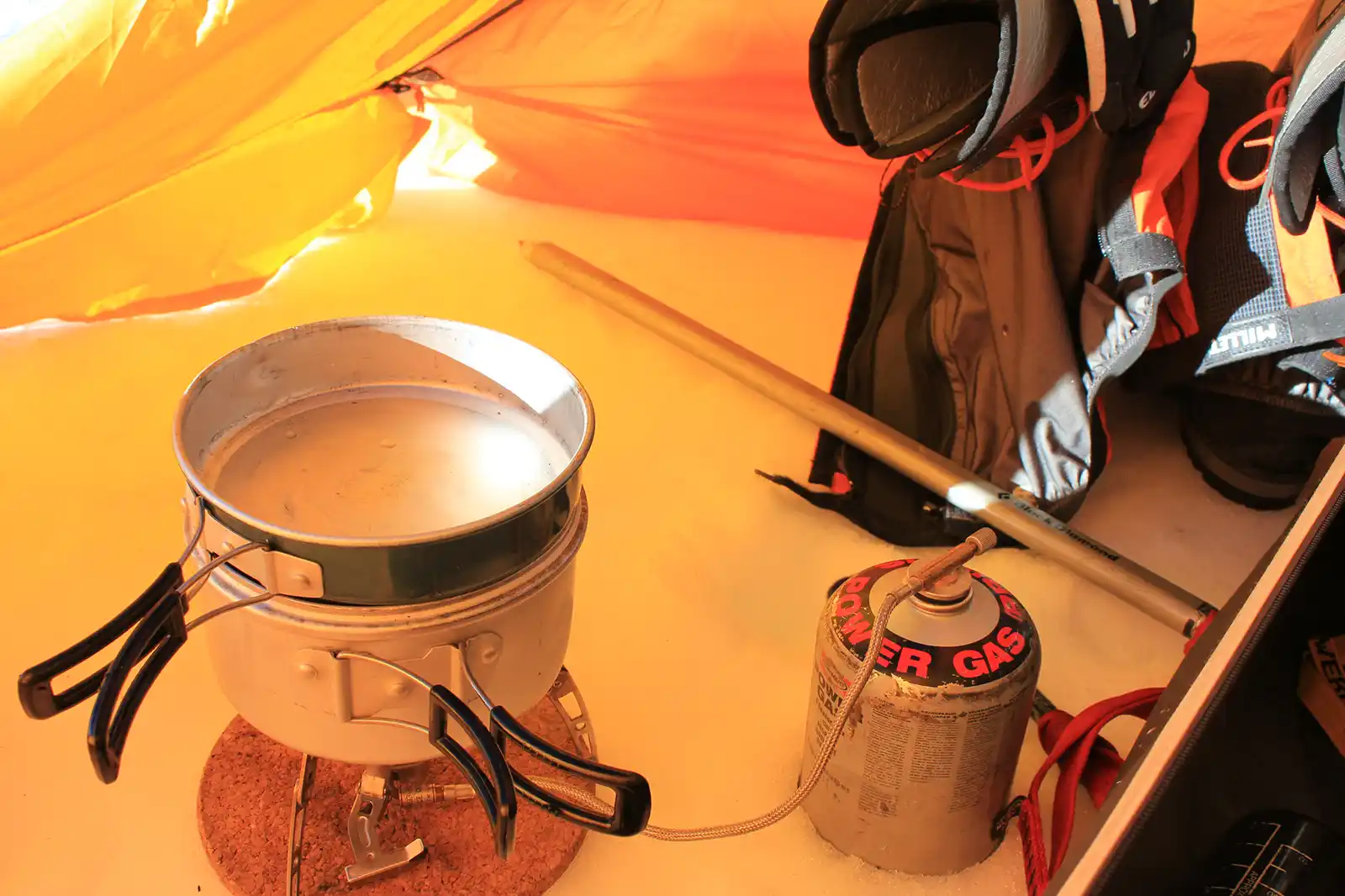
They also use this time to explore the nearby areas, which are quiet and less explored parts of the Himalayas.
Accommodation: Tented Camp
Meals: Breakfast, Lunch, and Dinner
Day 09: Trek from Kagkot Gaon to Panjing Village (4,200 m) - Trekking: 6-7 hours
The trek to Panjing village, located at an altitude of 4,200 meters, takes around 5 hours. Trekkers have the rare chance to really immerse themselves in the high-altitude way of life during this portion of the adventure.
As they ascend to higher altitudes, they encounter rugged terrain and thinner air, presenting challenges and rewards. Upon reaching Panjang village, the residents who have adapted to the high-altitude lifestyle warmly welcome trekkers.
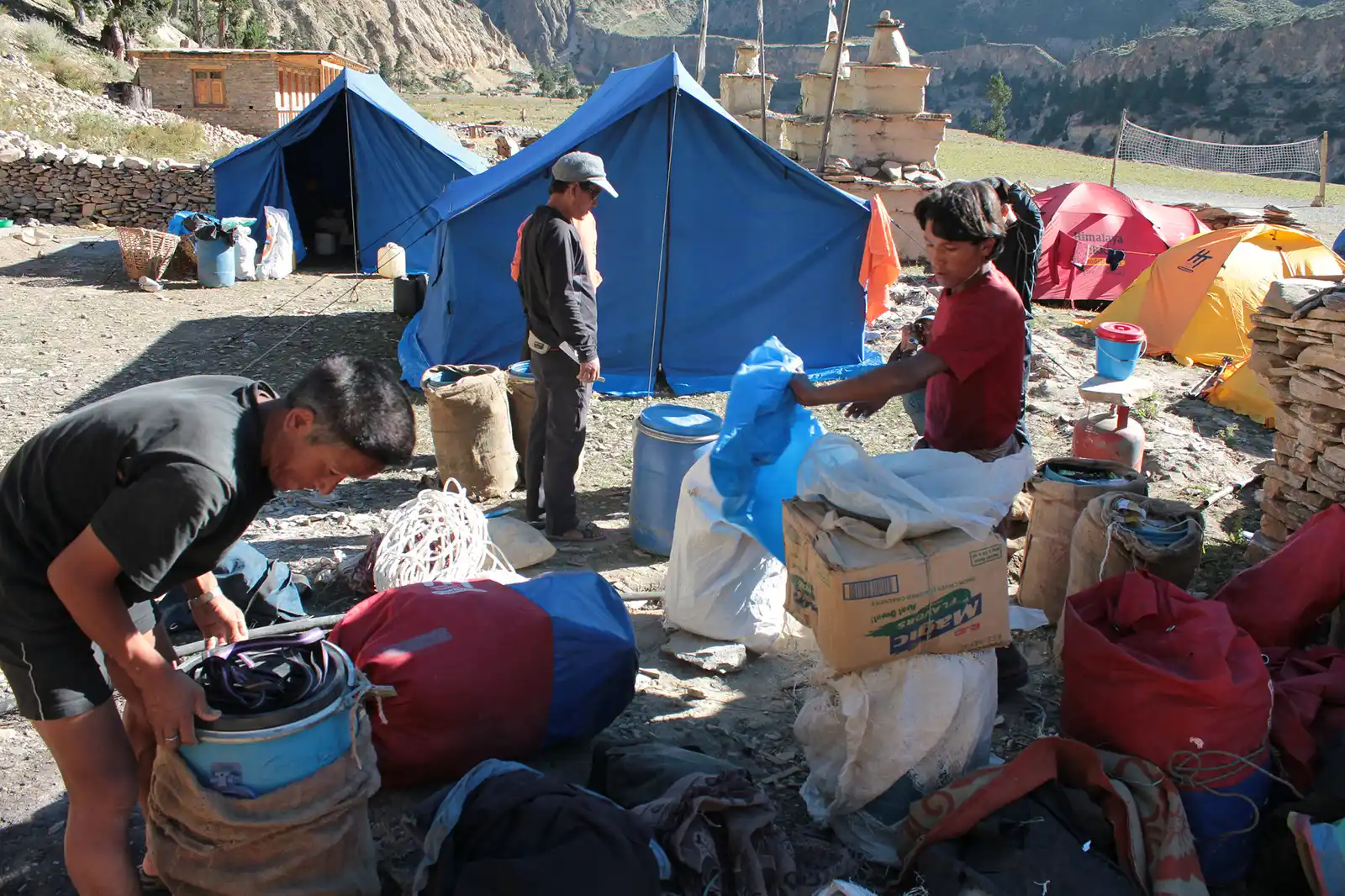
This interaction allows trekkers to gain valuable insights into the resilience and culture of the people who call these remote Himalayan areas home. The village is a testament to human endurance in the face of the challenging mountain environment.
Accommodation: Teahouse
Meals: Breakfast, Lunch, and Dinner
Day 10: Trek from Panjing Village to Putha Hiunchuli Base Camp Phedi (4,500 m) - Trekking: 6-7 hours
The trek continues as climbers head to Putha Hiunchuli Base Camp Phedi, steadily ascending to 4,500 meters, which takes about 5 hours. As they progress, the terrain becomes more demanding, signaling their entry into the high-altitude environment and bringing them closer to the base of Putha Hiunchuli.
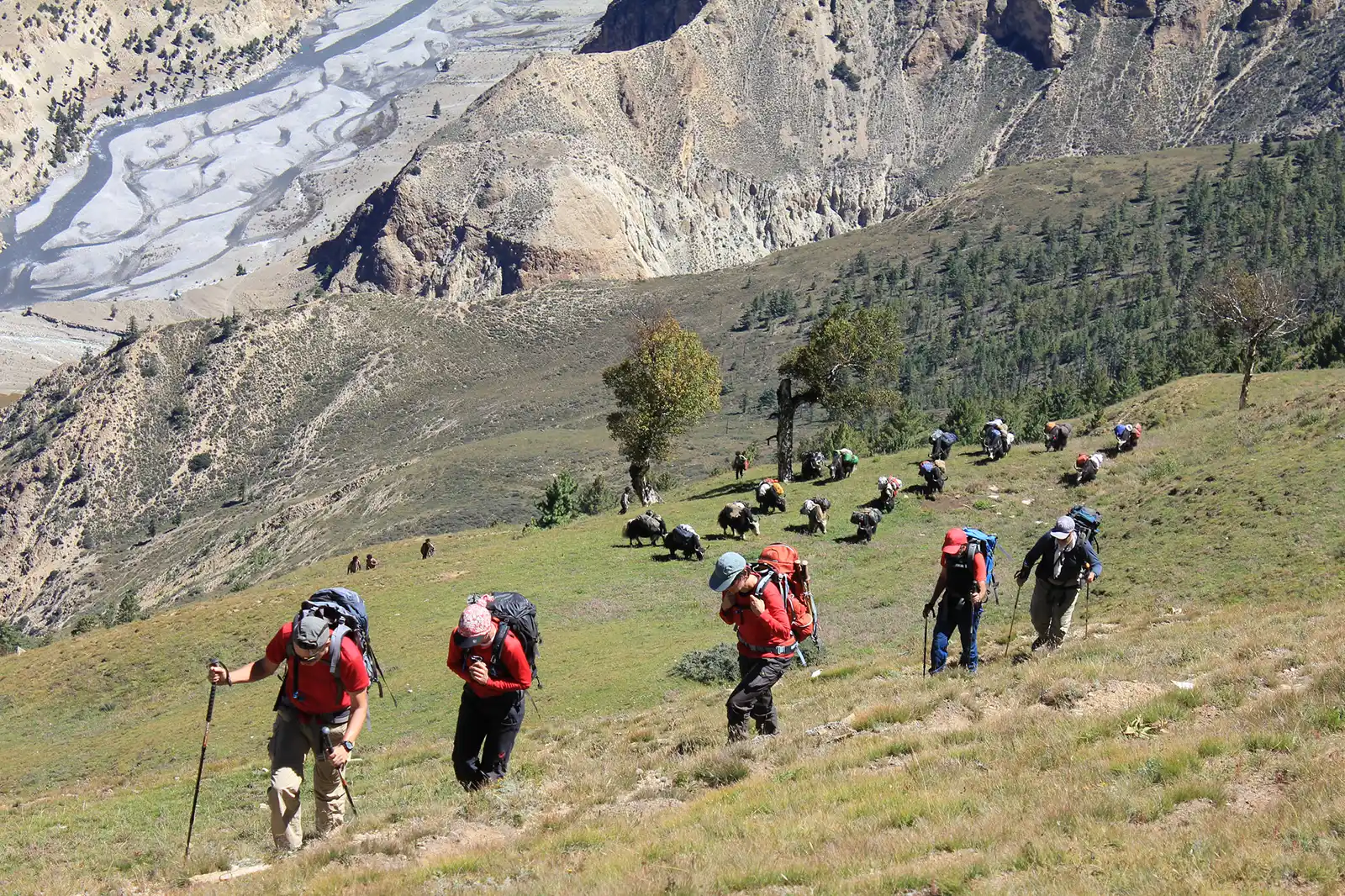
This challenging part of the trek exposes trekkers to the effects of higher altitudes, such as thinner air and increased physical exertion. It is a vital phase of the trek, preparing them for the forthcoming climb of Putha Hiunchuli, a demanding peak that demands acclimatization and thorough readiness.
Accommodation: Tented Camp
Meals: Breakfast, Lunch, and Dinner
Day 11: Trek from Base Camp Phedi to Putha Hiunchuli Base Camp (4,910 m) - Trekking: 3-4 hours
The trek ends with a 4-hour trek to reach the Putha Hiunchuli Base Camp, which is at 4,910 meters. This significant point marks the beginning of the actual climb to Putha Hiunchuli.
Upon arrival at the base camp, climbers prepare for the upcoming ascent. At the base camp, climbers engage in essential activities to ensure they are well-prepared and acclimatized for the climb.
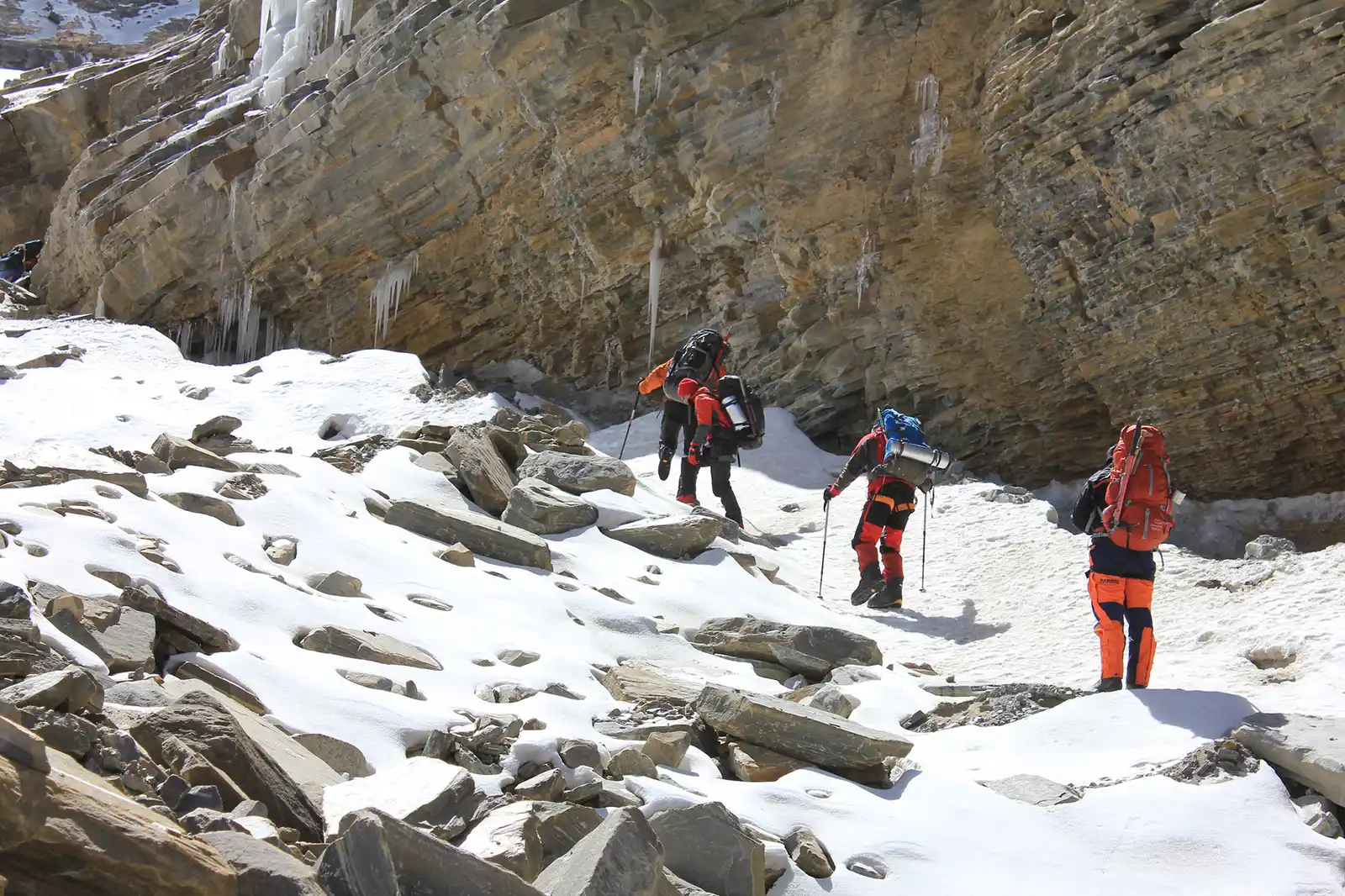
In order to adapt to the high-altitude environment, they must inspect their equipment, hone their climbing skills, and adhere to acclimatization regimens.
The climbers dedicate the day to laying the foundation for a safe and successful climb of Putha Hiunchuli.
Accommodation: Tented Camp
Meals: Breakfast, Lunch, and Dinner
Day 12-26: Base Camp Setup, 15-day Climbing Period, and Setting up Higher Camps
During these 15 days, the primary focus is on conquering the challenging ascent of Putha Hiunchuli. This period involves several critical tasks, including establishing higher camps along the climbing route at strategic locations.
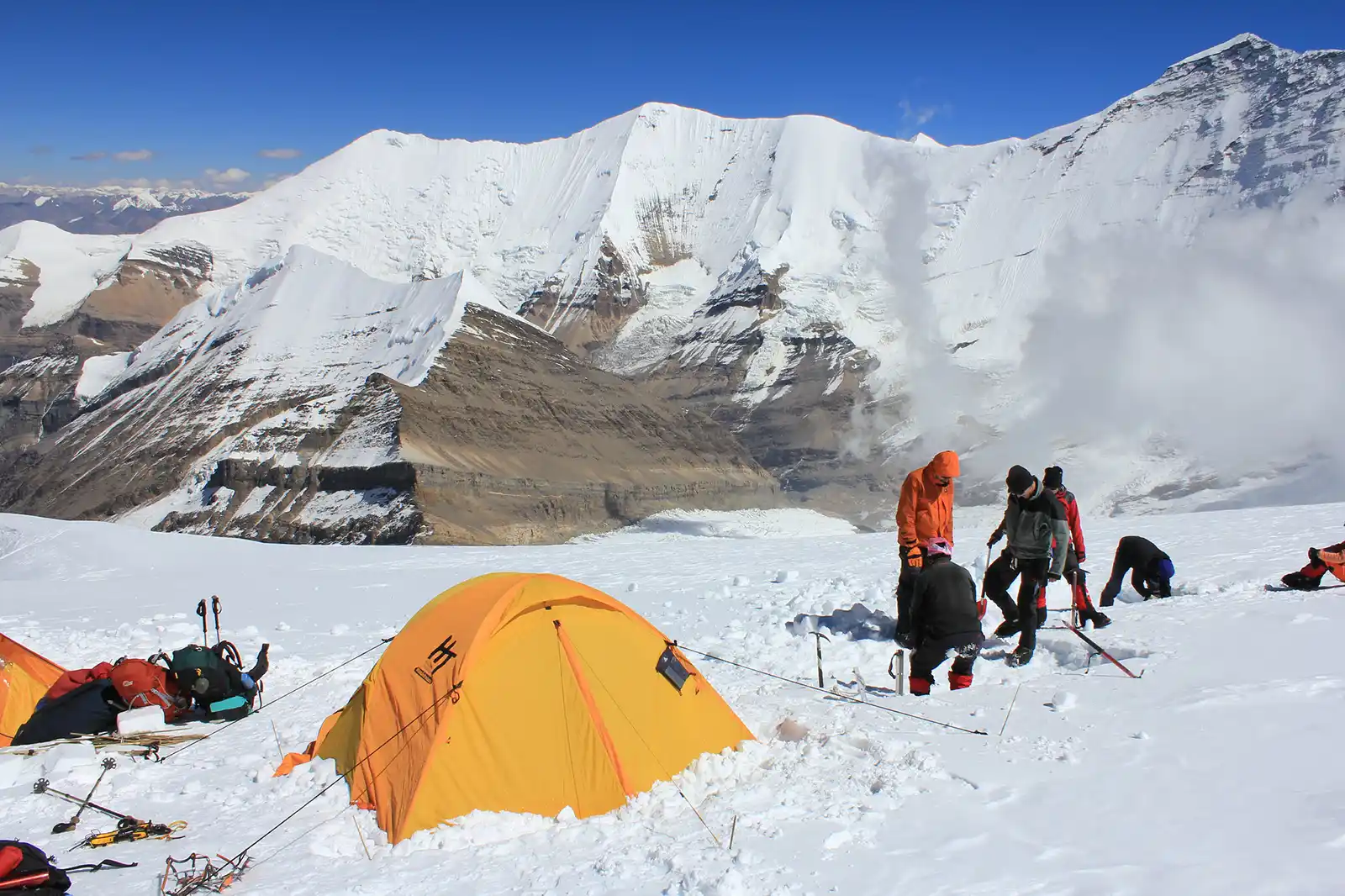
These higher camps serve as essential resting and acclimatization points, allowing climbers to adapt to the increasing altitude gradually. Acclimatization is a top priority during this phase, as climbers need to adjust to varying altitudes.
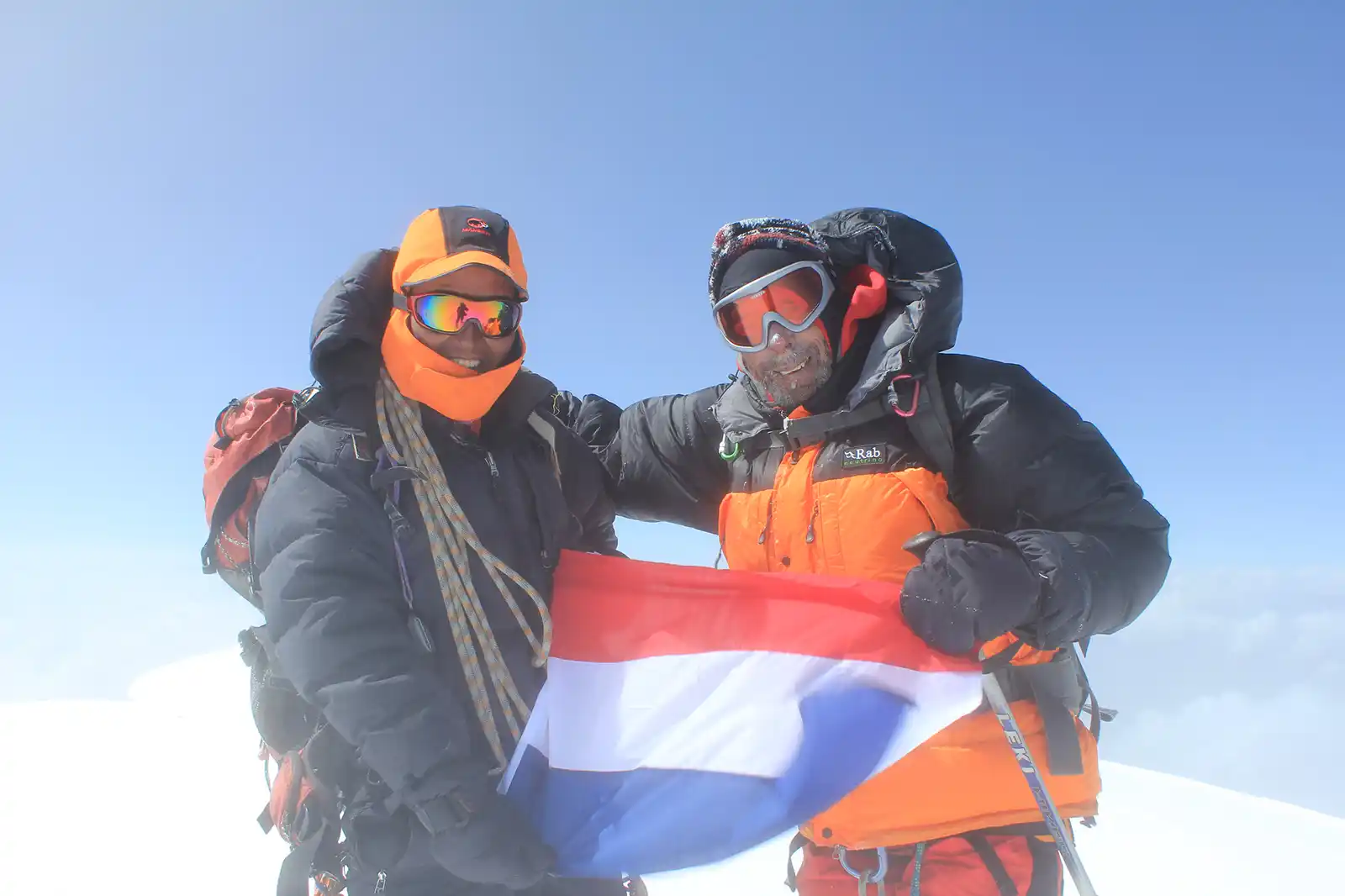
It is a crucial step in preventing altitude sickness and ensuring that climbers are physically prepared for the demanding climb. The goal of these 15 days is to monitor the Himalayas’ fast-changing weather attentively. Climbers must remain flexible and ready to adjust their plans to ensure safety.
This period demands intense physical and mental preparation as climbers approach the ultimate goal of reaching the summit of Putha Hiunchuli.
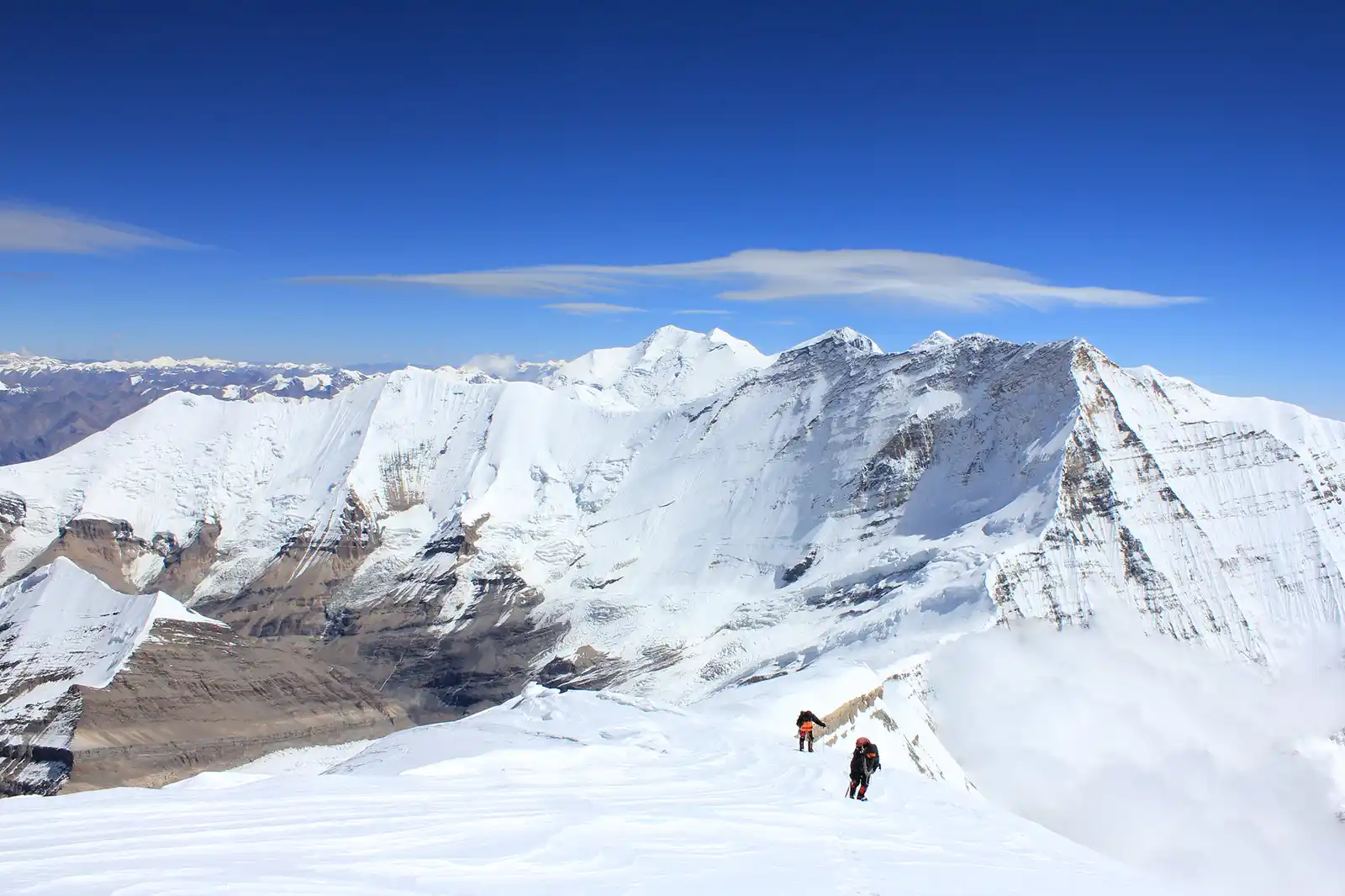
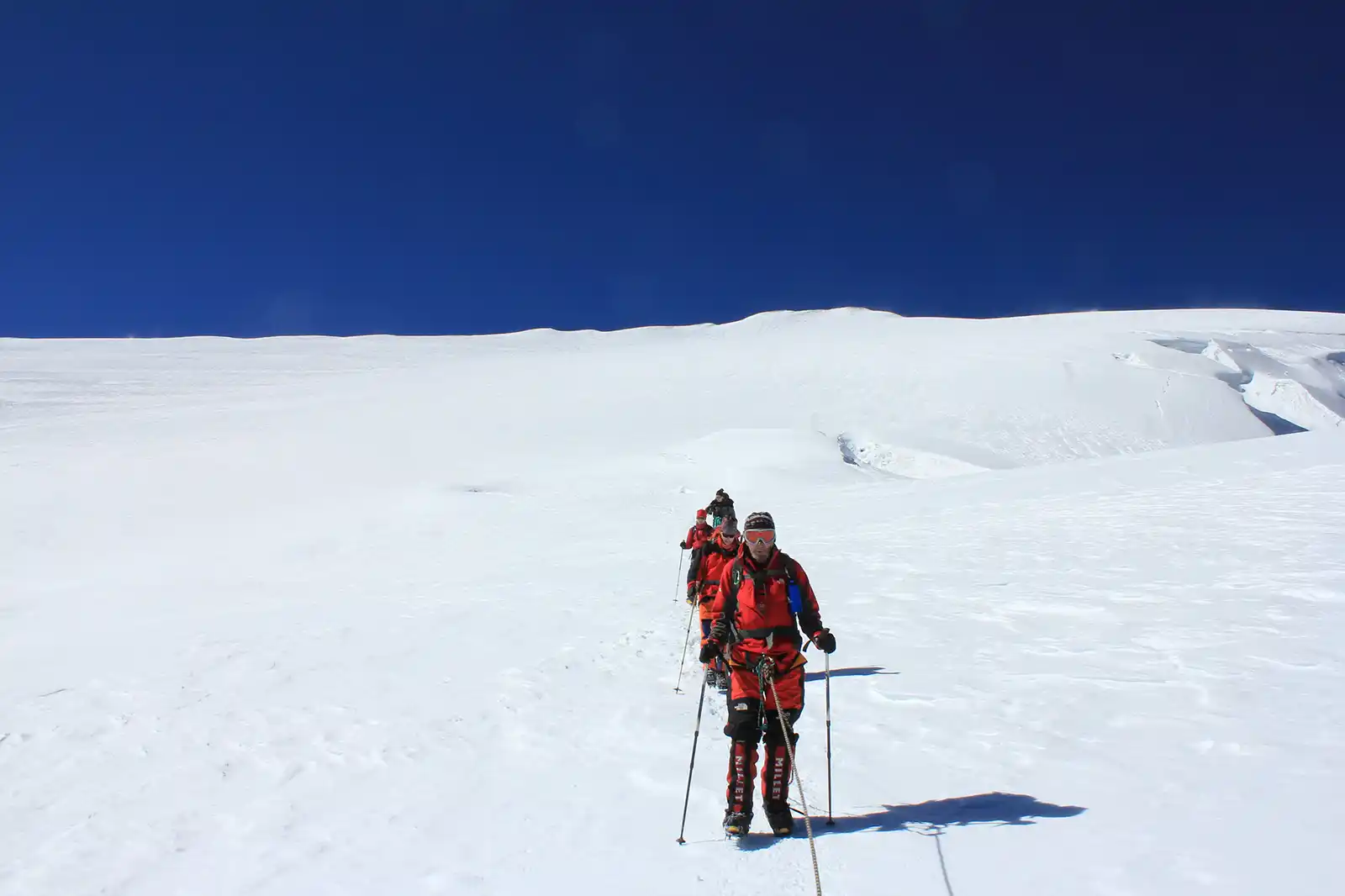
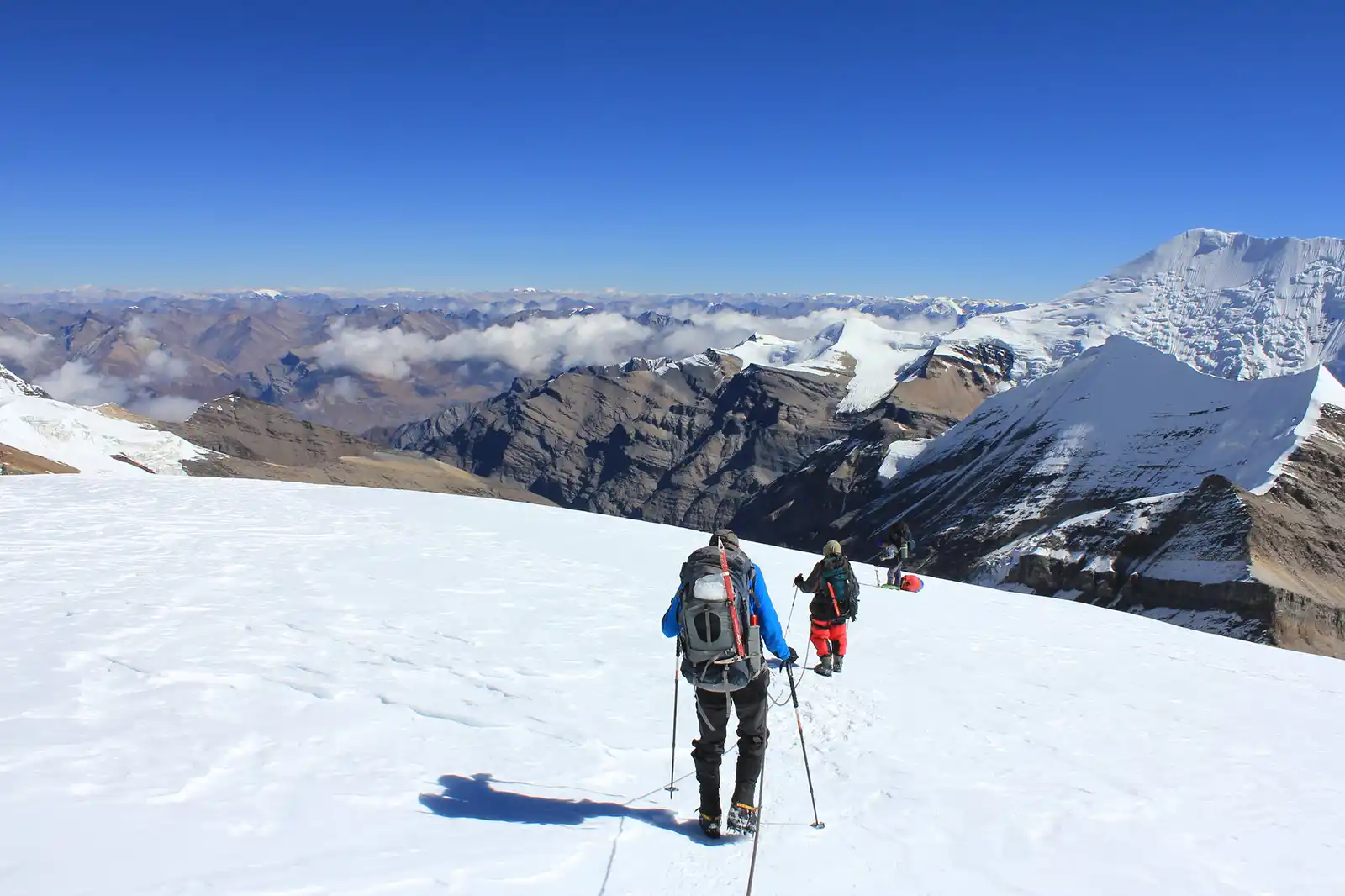
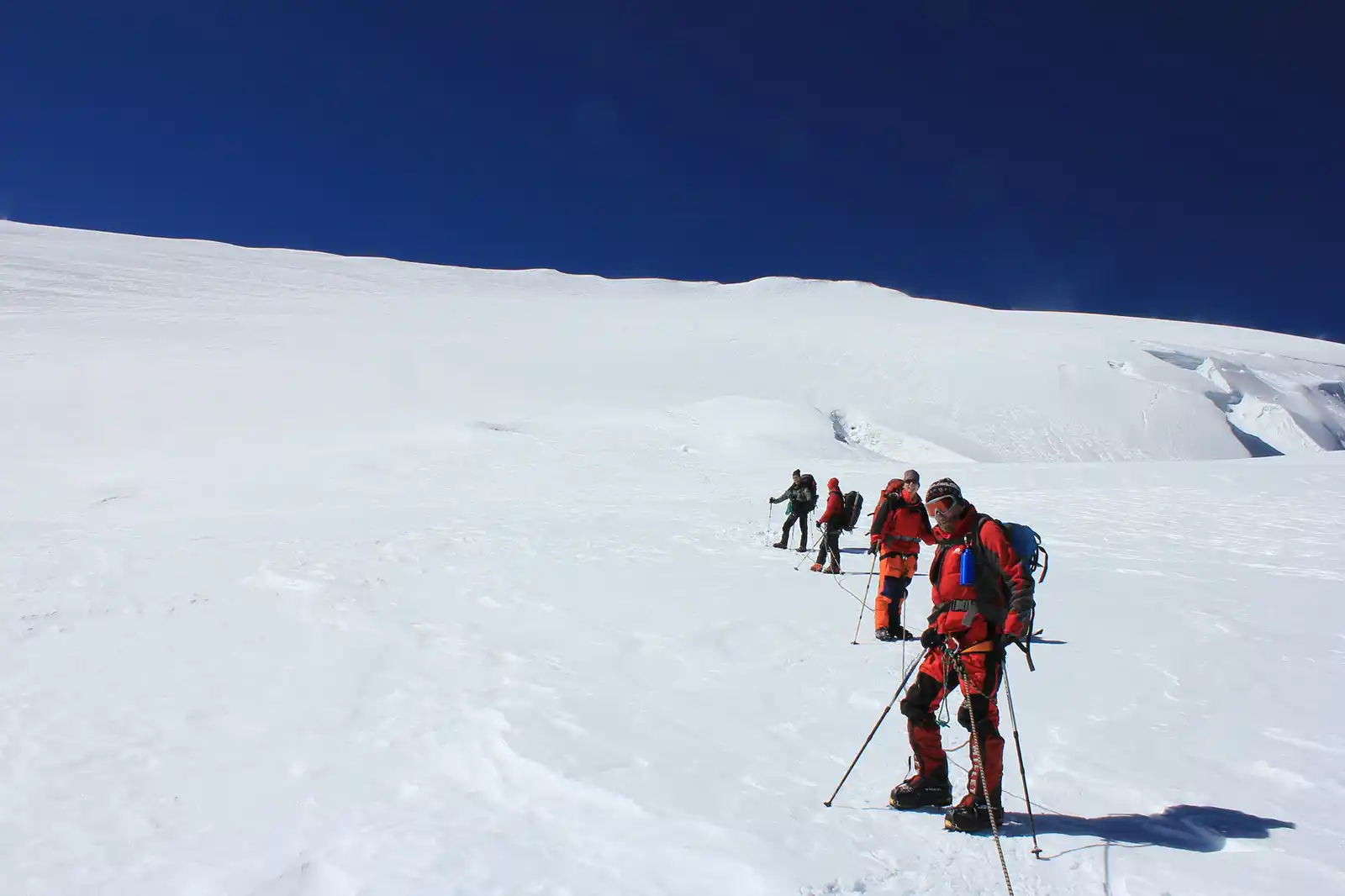
Accommodation: Tented Camp
Meals: Breakfast, Lunch, and Dinner
Day 27: Base Camp Packing and Garbage Collection
On this day, climbers diligently pack their belongings and clean up the base camp. This responsible action plays a vital role in the expedition and contributes to preserving the pristine Himalayan environment.
The goal is to leave no trace and ensure the mountain remains untouched and unspoiled.
Climbers are responsible for gathering and properly disposing of any waste or garbage generated during their stay at the base camp.
Their steadfast dedication to preserving the area’s natural beauty for upcoming generations is evident in their profound reverence for it.
Accommodation: Tented Camp
Meals: Breakfast, Lunch, and Dinner
Day 28: Trek back to Kagkot Village - Trekking: 6-7 hours
Trekkers continue their trek with a 7-hour descent, retracing their path back to Kagkot village through familiar terrain.
This part of the expedition signifies the shift from the high-altitude mountain environment to lower regions, allowing trekkers to contemplate their achievements and reconnect with the local culture and Himalayan landscapes.
Accommodation: Teahouse
Meals: Breakfast, Lunch, and Dinner
Day 29: Trek from Kagkot Village to Tarakot or Lashicap Village (2,775 m) - Trekking: 6-7 hours
As the trek continues, trekkers descend for 7 hours to reach either Tarakot or Lashicap village, depending on the chosen route.
The downward trek reveals new angles and vistas, allowing trekkers to admire the terrain differently.
Trekkers can experience the natural beauty and peace of the Himalayas once more as they descend through these gorgeous settings.
The trek contrasts with the ascent, focusing on descending through the region’s stunning landscapes.
Accommodation: Teahouse
Meals: Breakfast, Lunch, and Dinner
Day 30: Trek from Tarakot or Lashicap Village to Dunai; Drive to Jhupal - Trekking: 6-7 hours; Drive: 1 hour
On this day, trekkers wrap up their trek as they head back to Dunai, where the trek initially began, and then they drive to Jhupal.
Now that the trekking section of their expedition has come to an end, hikers can reflect on their experiences and successes in the isolated Himalayan regions.
It represents a shift from the challenging trails to more convenient transportation, bringing them nearer to the end of their Himalayan expedition.
Accommodation: Teahouse
Meals: Breakfast, Lunch, and Dinner
Day 31: Fly from Juphal to Nepalgunj and connection flight to Kathmandu
The travelers return from Jhupal to Nepalgunj and then take a flight back to Kathmandu, signaling the end of their major adventure.
This shift from the remote Himalayan region to the busy capital city of Kathmandu gives them a chance to think about their expedition while experiencing the comforts and conveniences of city life before returning to their own countries.
Accommodation: Hotel
Meals: Breakfast, Lunch, and Dinner
Day 32: Free day in Kathmandu
On this day in Kathmandu, trekkers have the valuable opportunity to engage in personal activities.
They can explore the city’s cultural attractions further, shop for souvenirs to commemorate their Putha Hiunchuli Expedition adventure, or relax and enjoy the unique ambiance of Kathmandu.
This free day empowers trekkers to tailor their experiences to their preferences and make the most of their remaining time in Nepal.
With no predefined schedule, trekkers can fully immerse themselves in the lively atmosphere of Kathmandu, taking in its sights, sounds, and culinary delights.
Accommodation: The Everest Hotel
Meals: Breakfast
Day 33: International Departure
The final day of the Putha Hiunchuli Expedition adventure is about travelers heading home.
It is when they wrap up their thrilling Himalayan expedition, full of challenges and accomplishments.
As they say their goodbyes to Nepal, they carry memories of the formidable mountains, peaceful scenery, and the triumphant climb to Putha Hiunchuli’s summit.
Meal: Breakfast
Customize this trip with help from our local travel specialist that matches your interests.
Includes & Excludes
What is included?
- Airport transfers and guided sightseeing in Kathmandu Valley with entrance fees
- Hotel in Kathmandu, teahouses for trekking, and tented accommodation during Putha Hiunchuli Expedition
- Meals during trekking and the Putha Hiunchuli Expedition period
- All necessary staff with experienced English-speaking climbing guide, cook, assistant climbing leader (5 trekkers 1 assistant guide), and Sherpa porters
- All land transportation as per an itinerary
- All necessary paperwork like trekking permits and Putha Hiunchuli Expedition permit
- Putha Hiunchuli Expedition equipment high-quality equipment like North Face or Mountain Hardwar tents, mattresses, and kitchen equipment
- Travel and rescue arrangements provide
- Welcome and farewell dinner
- Exclusive Medical Kit Bag
- All government and local taxes
What is excluded?
- Nepal Visa fee and International airfare
- Accommodation and meals in Kathmandu because of early arrival, late departure, and early return from the Putha Hiunchuli Expedition
- Altitude chamber or oxygen
- Travel and rescue insurance
- Personal climbing equipment
- Personal climbing guide on your request
- Personal expenses like phone calls, laundry, bar bills, mineral/boiled water, shower, etc
- Tips for your crews
Departure Dates
We also operate Private Trips.
Good To Know
Climbing Clothing
- Base layers
- Insulated jacket
- Hardshell jacket and pants
- Climbing pants
- Down suit (for high-altitude)
Footwear
- Mountaineering boots
- Gaiters
- Socks (wool or synthetic)
Headwear
- Climbing helmet
- Balaclava or buff
- Sunglasses with UV protection
- Ski goggles
Handwear
- Climbing gloves
- Mittens (for extreme cold)
Climbing Gear
- Climbing harness
- Ice axe
- Crampons
- Carabiners
- Ascender and descender devices
- Ropes (dynamic and static)
- Slings and runners
Safety Equipment
- Avalanche transceiver
- Shovel and probe (for avalanche safety)
- Harness
Camping Equipment
- Four-season tent
- Sleeping bag (rated for extreme cold)
- Insulated sleeping mat
- Stove and fuel
- Cookware and utensils
Technical Equipment
- GPS device
- Map and compass
- Altitude watch
- Climbing pack
- Trekking poles
Personal Items
- First aid kit
- Medications
- Toiletries
- Repair kit
- Headlamp with spare batteries
- Multi-tool or knife
- Sunscreen and lip balm with high SPF
Climbing Accessories
- Prusik cords
- Rappel device
- Climbing slings
High-Altitude Gear
- Oxygen cylinders and masks (if necessary)
- Portable altitude chamber (Gamow bag)
- High-altitude food and drinks
Communication
- Satellite phone or communication device
- Two-way radios
Documentation
- Climbing permits and identification documents
Trip Information
Best Season for Putha Hiunchuli Expedition
Spring Season (April to May): Spring is the best season to begin on a Putha Hiunchuli Expedition adventure because of its perfect weather. You can expect stable weather conditions with clear skies and very little rain or snow during this time. This reliable weather reduces the risk of dangerous events like avalanches.
Additionally, the temperatures are relatively warm in spring, which makes the climbing experience more comfortable, especially at higher elevations. As a special treat, spring brings the breathtaking sight of rhododendron forests in full bloom and vibrant alpine flowers, enhancing the natural beauty of the trek.
Autumn Season (Late September to October): Autumn is excellent for Putha Hiunchuli expeditions. Like spring, autumn offers climbers clear skies and minimal precipitation, ensuring stable weather conditions that enhance safety and visibility during the ascent. What sets autumn apart is the vibrant transformation of the landscape as foliage takes on rich hues, creating a picturesque setting.
Comfortable temperatures in autumn make the climbing experience more pleasant for both ascent and descent. This season combines favorable weather, stunning natural beauty, and ideal climbing conditions, making it an excellent choice for Putha Hiunchuli expeditions.
The Difficulty Level of Putha Hiunchuli Expedition
High Altitude: Putha Hiunchuli, situated in the Dhaulagiri Range, presents climbers with a formidable high-altitude mountaineering challenge. At 7,246 meters (23,773 feet) above sea level, Putha Hiunchuli is a big mountain that requires climbers to undergo extensive physical and mental preparation before starting a climbing adventure. The thin air at such elevations means significantly less oxygen, making careful acclimatization and oxygen management crucial.
Additionally, there’s a risk of altitude-related illnesses like Acute Mountain Sickness (AMS) and high altitude pulmonary Edema (HAPE), highlighting the importance of a gradual ascent and a thorough understanding of altitude physiology. Conquering Putha Hiunchuli demands technical climbing skills and a profound respect for the challenges posed by the mountain’s extreme altitude.
Technical Climbing: Climbers tackling Putha Hiunchuli need advanced technical climbing skills and specialized gear like ropes, crampons, ice axes, and harnesses. They must excel in various climbing techniques, especially on steep, icy sections.
Skilled in ice and rock climbing, safety equipment, and anchoring systems are vital for a safe ascent. Mastering these technical skills is critical for securing and successfully climbing the challenging and unpredictable Putha Hiunchuli.
Weather Variability: Climbers on Putha Hiunchuli need to be ready for the Himalayas’ unpredictable weather. They might face strong winds, heavy snowfall, and extreme cold, which can be risky during the climb. The sudden weather changes can reduce visibility, making it hard to navigate and increasing the risk of avalanches and frostbite.
Climbers must keep a close eye on weather forecasts and be ready to change their plans to stay safe and make their Putha Hiunchuli Expedition successful.
Avalanche Risk: Putha Hiunchuli is prone to avalanches, particularly in the winter and spring. Climbers must exercise extreme caution and make informed decisions to minimize their exposure to avalanche-prone areas. To do this, one must carefully assess the terrain, stay out of high-risk areas, and plan climbs to avoid times when there is a greater risk of an avalanche, such as during periods of heavy snowfall or freeze-thaw cycles.
Adhering to safety procedures, such as carrying avalanche safety equipment like transceivers, shovels, and probes, is crucial to reducing the risks associated with avalanches during the Putha Hiunchuli Expedition.
Altitude Sickness: Acute Mountain Sickness (AMS) and other altitude-related ailments are risk factors in high-altitude locations like Putha Hiunchuli. Climbers should concentrate on appropriate acclimatization, which entails progressively increasing elevation and allowing the body time to acclimate to decreased oxygen levels at higher elevations in order to lower these hazards. Recognizing symptoms like headaches, nausea, dizziness, and fatigue is essential.
Suppose anyone experiences these symptoms or other altitude-related issues. In that case, they should take them seriously and be ready to descend to lower elevations for safety. Keeping a close eye on one’s health and the health of fellow climbers is a fundamental aspect of ensuring safety during the Putha Hiunchuli Expedition.
Long Duration: Climbing Putha Hiunchuli is a lengthy and demanding trek that spans several weeks, including phases like acclimatization and summit attempts. This extended expedition places substantial physical and mental demands on climbers.
They must cope with the challenges of high-altitude mountaineering, which involves strenuous climbs, harsh weather conditions, and the necessity for thorough planning and preparation. Throughout this prolonged period, climbers must uphold their physical fitness, mental fortitude, and adaptability to changing circumstances, making it a rigorous and mentally challenging adventure.
Obtaining Permits and Guides
Firstly, climbers must acquire permits issued by the Nepal government. These permits require climbers to provide expedition details like dates, routes, and the number of participants. They serve as legal requirements and aid in tracking and safeguarding climbers in the remote mountain region. Additionally, permit fees contribute to environmental conservation efforts in the area.
Secondly, we highly recommend enlisting local guides and support staff who are familiar with the terrain and challenges of the climb. These experts lead climbers safely, offer insights into mountain conditions, and provide assistance during emergencies. They also handle logistics, including accommodations, transportation, and food, allowing climbers to concentrate on the ascent.
Local guides’ expertise and regional knowledge are instrumental in ensuring a successful and secure Putha Hiunchuli Expedition experience. Collaborating with skilled guides and obtaining necessary permits are vital components of a well-prepared and responsible expedition.
The Best Route to Climb Putha Hiunchuli
Northeast Face Route: The Northeast Face Route is the most popular and preferred path to reach the summit of Putha Hiunchuli. It begins from the German Base Camp at approximately 4,525 meters and demands climbers possess technical climbing skills, including ice and rock climbing proficiency. This route presents challenges in the form of navigating demanding ridges and sections.
Climbers strategically establish higher camps ascending to greater altitudes, facilitating essential acclimatization to the high-altitude environment. After acclimatization, climbers undertake the final push to reach the summit.
The advantages of this route lie in its well-established and commonly used path, but it requires thorough preparation, including the acquisition of proper equipment, training, and prior climbing experience. We advise climbers to prioritize safety and consider guided expeditions for a safer and more successful Putha Hiunchuli Expedition experience.
Southwest Ridge Route: The Southwest Ridge Route begins at the German Base Camp, around 4,525 meters above sea level, and follows the southwest ridge of Putha Hiunchuli. While it’s less commonly chosen than the northeast face route, it offers climbers a unique and different climbing experience with its perspective.
Like the northeast face route, this path demands climbers to have technical skills. Climbing along the ridge comes with challenges, underlining the importance of proper training and previous mountaineering experience.
The Southwest Ridge Route presents a feasible option for climbers looking for a less-trod path to the summit, provided they carefully evaluate the weather and climbing conditions, acquire the necessary gear, and think about participating in guided expeditions to guarantee success and safety while maintaining the highest priority on safety.
West Face Route: The West Face Route is a more challenging path up Putha Hiunchuli because it involves steep ice and rock sections. Climbers attempting this route need advanced mountaineering skills and must be well-prepared with safety measures and equipment.
Extensive training and technical climbing experience are necessary; having experienced guides is crucial for a safe ascent. This route is riskier due to its difficulty, so it’s best suited for skilled mountaineers seeking a tough challenge. Climbers should carefully evaluate their abilities and conditions before choosing this route to the Putha Hiunchuli summit.
Insurance
Insurance is crucial when planning a Putha Hiunchuli Expedition trip. Climbers need comprehensive mountaineering insurance that covers high-altitude climbing, emergency evacuations, and medical expenses related to altitude-related illnesses or accidents.
It is important to carefully check the policy to ensure it’s suitable for Himalayan climbing and includes the necessary protections. With the right insurance, climbers have financial security and peace of mind in case unexpected situations occur during the climb, making it safer and more secure for them.
Frequently Asked Questions
Authorized agencies in Nepal secure climbing permits for Putha Hiunchuli. To obtain these permits, you must submit a detailed application outlining the specifics of your expedition, including proposed dates, the chosen route, and the number of climbers.
These permits are legally required to ensure climbers’ safety and environmental conservation in the remote mountain region. Collaborating with a reputable agency is essential to facilitate the permit application process.
There are several routes available to climbers for ascending Putha Hiunchuli. The routes that are most well-known and often traveled are the West Face, Southwest Ridge, and Northeast Face routes. Each route offers a unique and distinct climbing experience, catering to various preferences and skill levels.
A high level of physical fitness is paramount for Putha Hiunchuli climbers. Outstanding strength, cardiovascular fitness, endurance, and mental toughness are all included in this. Climbers must prepare their bodies for the strenuous conditions of high-altitude mountaineering.
In order for your body to adapt to the lower oxygen levels at high elevations, acclimatization is essential. It entails progressively climbing while giving your body time to adjust.
In order to properly acclimate, climbers set up higher camps at different elevations and spend time at these higher elevations. This procedure guarantees a safer climb and helps lower the risk of illnesses associated with altitude.
Climbing Putha Hiunchuli presents several risks and challenges. These include altitude-related illnesses like Acute Mountain Sickness (AMS), the threat of avalanches (especially during winter and spring), extreme weather conditions, and technical difficulties in navigating steep and icy sections.
Proper preparation, adherence to safety protocols, and mountaineering experience are essential to mitigate these risks.
Safety is a top priority during a Putha Hiunchuli climbing expedition. Safety measures include carrying avalanche safety equipment such as transceivers, shovels, and probes to respond to avalanche risks.
Having experienced guides who are familiar with the terrain and conditions is crucial. Climbers use communication devices like satellite phones and two-way radios to maintain contact with base camps and emergency services.
Preparation for extreme weather conditions in the Himalayas is vital. Climbers should invest in proper clothing, including base layers, insulated jackets, hardshell gear, and down suits for high altitudes.
Layering clothing is essential to stay warm and dry. Regularly monitoring weather forecasts is crucial to adjust plans and avoid adverse conditions.
Altitude-related illnesses, including Acute Mountain Sickness (AMS), high High-Altitude Pulmonary Edema (HAPE), and high High-Altitude Cerebral Edema (HACE), can occur due to rapid altitude gain.
To avoid these illnesses, climbers should prioritize proper acclimatization, ascend gradually, stay hydrated, and recognize the symptoms, including headaches, nausea, dizziness, and fatigue. Descending to lower altitudes if symptoms worsen is crucial for recovery.
Yes, there are emergency evacuation options available in the Himalayas. Climbers have the option to arrange helicopter rescues in the event of significant injuries or illnesses due to altitude.
Expedition organizers and guides typically have established protocols for emergency evacuations and communication with rescue services.
While solo climbing is possible, joining a group or expedition with experienced guides is generally safer and more advisable, especially when tackling challenging peaks like Putha Hiunchuli.
Skilled guides enhance the chances of a safe and successful ascent by offering safety and insightful knowledge of the route.
Climbers should obtain comprehensive mountaineering insurance, including high-altitude climbing coverage, emergency evacuations, and medical expenses related to altitude-related illnesses or accidents.
It is crucial to thoroughly go over the insurance coverage to make sure it covers any potential dangers related to the adventure and satisfies the unique criteria of climbing in the Himalayas.
In case of problems or emergencies during the expedition, climbers should follow their established emergency plan, which typically includes contacting base camps or guides for assistance.
Prioritizing safety and being prepared to initiate evacuation procedures if necessary is crucial for ensuring the well-being of climbers in emergencies.